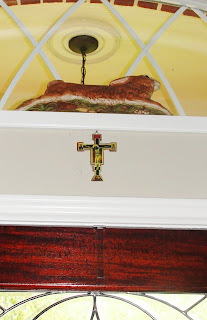Catholic homes are frequently adorned with statues or pictures of the saints. Saints are both the Christians of our own day as well as those faithful Christians who have gone to heaven. As Catholics, we have a tradition of acknowledging holy men and women of our past who we believe are in heaven. The Church, over the course of time, has formalized a process of honoring the saints through the what is called Canonization. When a Catholic is Canonized the entire Church then honors or "venerates" them. This is not worship as some people erroneously believe. Worship is for God alone. Veneration is simply "to honor". The confusion with worship versus honor leads other Christians to be suspicious of the Catholic view of saints. There is really nothing to fear.
When I ask a friend to pray for me we are joining together in Spirit for each other. Catholics believe that those who are in heaven continue to pray and intercede for us on Earth. We cannot be truly separated from them since we are all THE BODY of CHRIST. We are together in Christ. We believe that they can know what our needs are through Christ. To Catholics, asking a saint in heaven to intercede and pray for us is the same as asking a person on earth to pray for us. Those in heaven are even MORE ALIVE then we are!!!
Patron saints are particular people with whom we feel a special bond. Mary, the Mother of God, is the most holy of all saints. She is the mother of Jesus and of the Church. The particular patron saints of our home include St. Joseph, St. Anne (the mother of Mary), St. Anthony of Padua, and St. Thomas Aquinus. My oldest son has a particular devotion to St. Francis of Asisi. I have a particular devotion to Blessed John Paul II. I believe he "prayed" me back into the church. I ask him to continue to watch over my family; particularly my sons. When I notice the statues or pictures of the saints around my home it is the same as if it were a photo of a family member. They are my family "IN CHRIST." The items are not idols, but more like "family photos."










